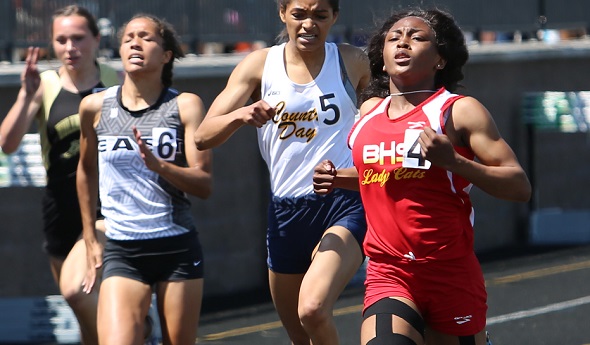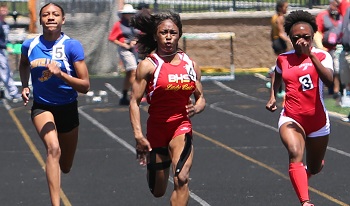
Williams Races to Place with All-Time Best
By
Paul Costanzo
Special for MHSAA.com
April 18, 2019
Bridgeport girls track coach Rick Popp said he believes his star sprinter Payten Williams has the potential to be a world champion.
 The high praise is something Williams appreciates, as she said it shows her coach has faith in her. But does the senior have that same faith in herself?
The high praise is something Williams appreciates, as she said it shows her coach has faith in her. But does the senior have that same faith in herself?
Williams was as quick to answer that as she is on the track: “Yes.”
“Payten is crazy fast,” Popp said. “She’s been the fastest girl in the state of Michigan the past two years. When you watch her run, her leg speed is insane. We don’t have a boy that can beat her in the 40 meters. The girl is just crazy lightspeed right now.”
While a world championship is a lofty goal, it’s hard to argue with Popp’s current assessment of Williams, the reigning MHSAA Lower Peninsula Division 2 champion in the 100 and 200 meters. During the past two years, she’s lost just two races, and both came at the MHSAA Finals her sophomore year. She placed fourth in both. She wasn’t unbeaten as a freshman, but she still finished first more than she didn’t and placed sixth at the Finals in the 200.
Her personal best in the 200 meters is 24.26 seconds, which she ran in July 2018 at the United States Track and Field Junior Olympics in North Carolina, placing 10th. That time would be an MHSAA Finals record in all but Division 1. Her personal best in the 100 is 12.06, which she ran at the 2018 MHSAA Finals, when she won by nearly half a second – second place came in at 12.55.
“Every state record should be gone,” Popp said, alluding to Williams breaking them. “Every all-time state record should be gone. When she’s dialed in, she’s lightspeed. She flies off her feet better than most anybody I’ve ever seen.”
Williams said she’s always been fast, but it took good coaching to help her reach these heights. That’s something she said she began to receive while in middle school from her AAU coaches, and that has continued into high school with them and Popp.
As things started to click, Williams started thinking big.
 “It felt great – it felt that I was going to become something,” Williams said. “I had a lot of people looking up to me, so I knew I had to keep going further. Making it all the way to the Olympics is something that’s big for me.”
“It felt great – it felt that I was going to become something,” Williams said. “I had a lot of people looking up to me, so I knew I had to keep going further. Making it all the way to the Olympics is something that’s big for me.”
She said she’s made a decision on which college she will be attending, but that she isn’t ready to make an announcement.
Her focus for now is on finishing her high school career strong. That includes breaking the 24-second and 12-second barriers in her respective races, although she was quick to note that the 100 isn’t really her race despite the fact she’s been dominant in it for two years.
“The 200 is my race,” she said. “I just like the race; it’s hard to explain it.”
She said that even after winning the 100 at last year’s Finals, she was more concerned with the 200 she still had to run. That doesn’t mean she wasn’t happy about the double.
“It felt great,” she said. “My mom was like, ‘You’re going to get this. You’re going to become a state champion.’ I was like, ‘No mom, don’t think that.’ But then she was right.”
The times are more important to Williams than winning races. With such lofty goals and recent championship results, focusing on racing the clock could be her best path to reaching them.
“I just focus on getting to the finish line and how I run,” she said. “I don’t think about anything else. I just think about myself and the track.”
Williams has yet to run an outdoor race this season, but she did win a pair of indoor races at Saginaw Valley State in late March, claiming the 60 meters in 7.74 seconds and the 200 in 25.41.
She said she’s been off to a slower start this season, as she’s had to devote more time to her family, specifically helping care for her grandfather. While she didn’t want to elaborate, she did say that she’s getting back to practicing full time and expects to have another strong season.
There’s plenty for her to work for, including repeat championships, state records, getting closer to her Olympic dreams, and her family.
“I’m pushing myself by using my strength as my motivation,” she said. “And I’m doing it for my granddad.”
 Paul Costanzo served as a sportswriter at The Port Huron Times Herald from 2006-15, including three years as lead sportswriter, and prior to that as sports editor at the Hillsdale Daily News from 2005-06. He can be reached at [email protected] with story ideas for Genesee, Lapeer, St. Clair, Sanilac, Huron, Tuscola, Saginaw, Bay, Arenac, Midland and Gladwin counties.
Paul Costanzo served as a sportswriter at The Port Huron Times Herald from 2006-15, including three years as lead sportswriter, and prior to that as sports editor at the Hillsdale Daily News from 2005-06. He can be reached at [email protected] with story ideas for Genesee, Lapeer, St. Clair, Sanilac, Huron, Tuscola, Saginaw, Bay, Arenac, Midland and Gladwin counties.
PHOTOS: (Top) Bridgeport's Payten Williams, far right, surges through the finish in winning the 200 meters at last year's Lower Peninsula Division 2 Finals. (Middle) Williams, middle, leads the 100 as contenders power through the final paces of that sprint. (Click to see more from RunMichigan.com.)

Hastings Relays Reigns as State's Oldest Continuous Track & Field Meet
By
Steve Vedder
Special for MHSAA.com
April 10, 2024
Bob Branch remembers dabbling in other sports, but his first love was always running.
 The Hastings High School graduate admits he could never hit a baseball, football didn't especially appeal to him and basketball was just another way to spend time with friends. But for Branch, now 93, there was always track. That's the sport where his fondest and sharpest memories remain. And if you're talking track, many of his favorite memories come from participation in the state's oldest continuous track meet, the Hastings Relays.
The Hastings High School graduate admits he could never hit a baseball, football didn't especially appeal to him and basketball was just another way to spend time with friends. But for Branch, now 93, there was always track. That's the sport where his fondest and sharpest memories remain. And if you're talking track, many of his favorite memories come from participation in the state's oldest continuous track meet, the Hastings Relays.
Always held in early April, the meet dates back to 1937 – a bygone time that saw the first hostilities of World War II, gas at 20 cents a gallon and a loaf of bread selling for a dime.
And at a dusty old track surrounding the county fairgrounds in Hastings, a small relay event that included a scattering of participants from a dozen high schools was taking its first tentative steps.
Branch recalls a time when kids would run home after track practice because there were no buses, inexperienced young coaches had little actual knowledge of running fundamentals, and athletes looked at the sport as an afterthought after spending most of their high school days playing football and basketball.
 For Branch, the relays were the ideal way to ease into the track season.
For Branch, the relays were the ideal way to ease into the track season.
"I just liked to run," said Branch. "I remember I anchored a relay with my brother, and it always seemed cold when we had that meet. I remember teams would come from all over and you saw a lot of good athletes. Everybody seemed to have someone who was really good. Track wasn't very popular at that time, but I have a lot of good memories from running."
The Hastings Relays, which has changed formats and even names during its nearly nine-decade history, would traditionally kick off the track season. The meet was originally held at a makeshift quarter-mile track which surrounded the town's fairgrounds and was part of the city's annual Hastings Carnival – the track would become the midway during fair time.
The meet eventually moved to Johnson Field when the football field was dedicated in 1949 and ballooned to as many as 50 teams at its peak in 1957. For more than seven decades it was known as the Hastings Relays and then the Hastings Co-Ed relays before becoming the current Hastings Invitational, with the latest edition scheduled for Friday.
Johnson Field had a cinder track before it became an all-weather surface in the 1980s. During a time long before computers would be used to organize meet heats in mere minutes, Hastings coaches of all sports – defined as "volunteers" by the athletic department – would meet on the Friday before competition to hash out events.
People associated with the meet still recall the camaraderie built on those long Friday nights, followed by working what would often become 10-hour meets. Steve Hoke has been involved since watching his father, Jack, who coached teams at 15 of the meets beginning in 1951 and also had run in the first Hastings Relays. Steve Hoke later competed in the Relays as well during the early 1970s before becoming an assistant track coach, later the Hastings athletic director and now a volunteer worker.
"It was always a huge deal," said Hoke, who said the meet began as a pure relay event before transitioning to its current team format in the 1990s. "I remember we'd line the track the night before, and all the coaches would come to the house to organize everything. There was a brotherhood.”
 If you quiz many of the fleet of volunteers who've worked the relays over the years, each has a different memory from the meet. While Hoke describes the brotherhood and Branch the outstanding competition, others remember weather and the time a thunderstorm wiped out the line markings on the cinder track, or waking up to find three inches of snow that caused a rare cancellation of the meet. Others recall the shock of moving from the cinder to all-weather track or using the meet as an early measuring stick of what it would take to qualify for the state meet. The real old-timers remember the meet disappearing for three years during World War II.
If you quiz many of the fleet of volunteers who've worked the relays over the years, each has a different memory from the meet. While Hoke describes the brotherhood and Branch the outstanding competition, others remember weather and the time a thunderstorm wiped out the line markings on the cinder track, or waking up to find three inches of snow that caused a rare cancellation of the meet. Others recall the shock of moving from the cinder to all-weather track or using the meet as an early measuring stick of what it would take to qualify for the state meet. The real old-timers remember the meet disappearing for three years during World War II.
Hastings native and Western Michigan grad Tom Duits was the state’s second collegian to break the four-minute mile when he ran a 3:59.2 at a meet in Philadelphia in 1978. Duits, who ran in three Hastings Relays, was in line to join the U.S. Olympic team in 1980 before the United States pulled out of the games due to tension with Russia.
Duits has his own memories of the meet and the competition he faced there.
"I remember sunshine and being excited to be competing again. There were all these athletes swarming around; it was an awesome display of talent," he said. "It was always one of the best meets we'd be in. You could pretty much see the level of runners who would be at state, which made it a big deal. It was always early, but you could tell where you stood. It was great exposure."
Hastings track star Wayne Oom competed in four Hastings Relays from 1984-87. One of his sharpest memories was the difference between running on a raw cinder track versus the far more comfortable all-weather surface.
"Those cinders would grind into your skin," said Oom, part of the Hastings school record in the two-mile relay. "But I think it helped us because when we'd go to other tracks, it seemed we would run faster. I remember how competitive it was, especially in the distances. There were some great runners."
While participants have their unique memories, so do coaches. Former Saxons coach Paul Fulmer remembers 2008 when his team finished first on the boys side of the meet while his wife, Grand Haven coach Katie Kowalczyk-Fulmer, saw her girls team win the championship.
 "I knew we were one of the favorites to win because we were usually near the top of our conference and Regional," he said. "But then Katie's team was pretty good, and it was cool for them to win too."
"I knew we were one of the favorites to win because we were usually near the top of our conference and Regional," he said. "But then Katie's team was pretty good, and it was cool for them to win too."
Fulmer, who coached Hastings from 1978-81 and then 1985-2010, said at least part of the meet's popularity was derived from a unique way of scoring. Instead of individuals earning points solo, participants worked in pairs. For instance, two athletes would combine their shot put or long jump scores. New events such as the 1,500 relay and sprint medley were added.
"We had a tradition of being the state's oldest meet, and that was a big deal," Fulmer said. "And we ran a good relay; that attracted teams too. We took a lot of pride in that.
"And we'd get quite a lot of people to come to the meet. We'd set up until like 9 or 10 p.m., and then we'd have a party with all the coaches on Friday night."
While the meet has stretched 87 years, Branch said early participants and current runners have one thing in common: a drive to win. Branch ran in an era when the popularity of high school track was in its infancy. Today some of the best all-around athletes at a school are involved in the track program. The relays span the nearly nine decades in between.
"The quality of teams has gotten better and better," said Branch, the 1947 Lower Peninsula Class B Finals champ in the 220. "And this has made for a better meet. We would get guys who played football or baseball kind of drift into track, and that made the sport better. I think people began to appreciate track because we'd get teams from all over.
"We went from not really knowing what we were doing to track being a good sport. Even then, I'm not sure we appreciated what we had. We really liked the Hastings Relays and always wanted to do well there. It became popular and quite an honor to do well. Those are the kind of things I remember."
PHOTOS (Top) Racers run at the Hastings Relays, with several more awaiting their turns to compete at the longtime meet. (2) The author wrote on the 50th anniversary of the Relays for the Hastings Banner nearly 40 years ago. (3) Past athlete, coach and athletic director Steve Hoke shows some of the Relays awards from the 1930s. (4) Tom Duits was one of the state’s biggest track stars of the 1970s and ran in three Hastings Relays. (Top photo by Dan Goggins, Hoke photo provided by Steve Hoke and Duits photos provided by Tom Duits.)

